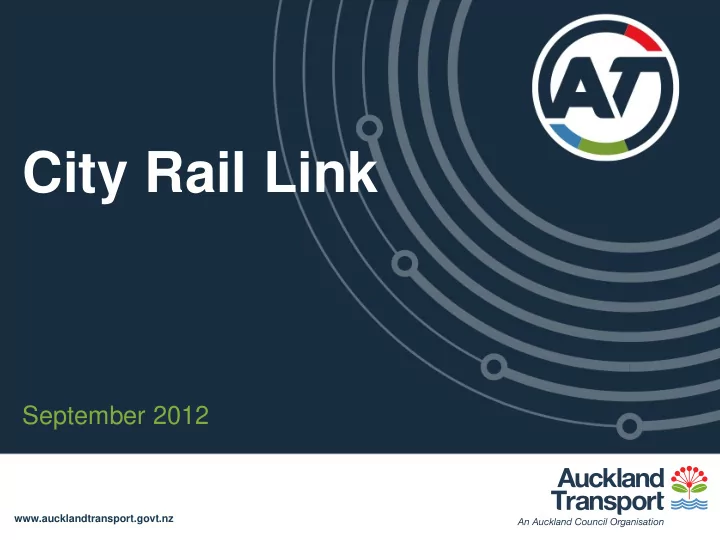

City Rail Link September 2012 www.aucklandtransport.govt.nz
Heritage Advisory Panel Presentation overview The City Rail Link team: • Deb Godinet– Workstream Leader CRL Notice of Requirement (NoR) • Aimee Barwick – Project Manager CRL NoR • Keri Davis-Miller – Planner CRL NoR Overview of: • City Rail Link - Overview, Benefits and Route • Experts • The City Rail Link methodology • Environmental Management Plan • Urban Design Framework and Heritage • Engagement NZHPT • Opportunities Questions
A vision for Auckland A globally competitive city • A thriving economic centre • A lifestyle that attracts and retains top talent • Transport solutions that allow for and shape growth • New Zealand is fifth in OECD for growth and most is in Auckland
Contributing to plans for Auckland The CRL is the foremost public transportation project in the first decade of Auckland Council’s 30 year Auckland Plan The CRL will create a quantum shift in the efficiency and frequency of rail services The CRL is one of Auckland’s key initiatives to reach its goals.
City Rail Link Route and construction methodology
City Rail Link Built Heritage Technical Expert Report
City Rail Link Integrated Transport Assessment August 2012
Technical Report to support Assessment of Environmental Effects (City Rail Link Notice of Requirement) Auckland Transport 25 July 2012 Contaminated Land Assessment City Rail Link
Categorisation of buildings and structures in study area. A,B,C… A : are those buildings, structures and areas that are identified in statutory lists such as the former Auckland City Council “Schedule of buildings, heritage properties, places, monuments and objects of special value and those subject to heritage orders”, the Historic Places Trust Register and the former Auckland Regional Council Cultural Heritage Inventory. B : are those buildings, structures and areas that are not included in formal lists, but that are seen as having heritage significance or making an important contribution to the built environment and its character. These buildings and structures are seen, therefore, as being ‘character defining’. C : are those buildings and structures that are seen as being ‘character supporting’ and form part of a group of significance as well as having some individual significance, but are not currently protected by statutory mechanisms.
Methodology – category description
Vibration • Temporary and varying effects related to construction. • Conservative effects assessment has been made for the NoR related to the indicative construction methodology and construction durations. • Preliminary indications from expert reports are that the risk of vibration induced building damage would likely be aesthetic.
Settlement • In Auckland, land rises and falls seasonally as groundwater levels vary- often seen as deep cracks in the lawn or doors that stick. • The types of buildings encountered along the CRL route are many and varied. • Preliminary assessments show vast majority will have negligible damage, cosmetic in nature and non-structural. • Monitoring will be used to confirm assessments of the likelihood of any damage.
Outcomes
Settlement monitoring • An array of laser measured monitoring points is established before construction commences -some condition surveys undertaken. • Monitoring points selected on existing buildings around sites of all work areas. • Regular readings taken prior, during and after construction completed. • ‘Traffic light’ system of continuous monitoring to avoid exceeding pre-defined limits.
Environmental Management Framework
Environmental Management Framework Built Heritage & Archaeology Delivery Work Plan The Built Heritage & Archaeology Delivery Work Plan (BHAWP) will describe how potential effects such as noise and vibration on built heritage and archaeology during construction will be addressed. Extract from BHADWP table: Wherever possible, the project will protect heritage assets within its control. Mitigation measures that address the potential impact on built heritage items will need to be considered on a building by building or site by site basis. The definition of these measures will be finalised in successive refinements as the project is developed, detailed information on the properties becomes available and the construction methods are finalised .
Mana Whenua Cultural Design Principles Mana/Rangatiratanga - Iwi require high level Treaty Based relationships with all key stakeholders. Whakapapa – Names and genealogical connections. Some names that are relevant to CRL are Te karanga a Hape, Te Raoukai. Tohu – Acknowledging the wider significant Iwi cultural land marks, maximising view shafts, enhancing cultural landscape connections. Taiao – Opportunities to bring natural landscape elements back into urban areas e.g, specific native trees and water. Mauri tu – Ensuring emphasis on maintaining environmental health life essence e.g focus on quality of water, soil and air (any underground waterways). Mahi toi – Creative dimension through creatively re-inscribing iwi narratives in architecture, urban design and public art. Ahi Kaa – Acknowledging post Treaty settlement environment where iwi living presences can include customary, cultural and commercial dimensions including joint ventures.
Urban Design Framework Principle BS1 Built Heritage Where built heritage is required for CRL station requirements, adaptive reuse strategies should be considered to preserve the building’s role in establishing the streetscape and urban character.
Engagement with New Zealand Historic Places Trust Pouhere Taonga (NZHPT) • Formal engagement with NZHPT began early in 2012 . • Regular meetings an opportunity for NZHPT to receive any updated information about the CRL and to provide a response to AT. • City Rail Link route walk , opportunity for NZHPT to look at potentially affected buildings and sites of historic significance and archaeological interest that may be affected during construction phases. • NZHPT input for public engagement and the interpretation of stories and histories along the route. • Engagement will continue throughout the Project lifecycle.
Opportunity for Enhancement and Regeneration
Questions
Recommend
More recommend